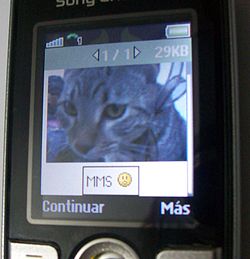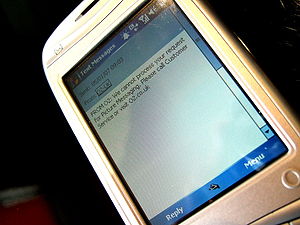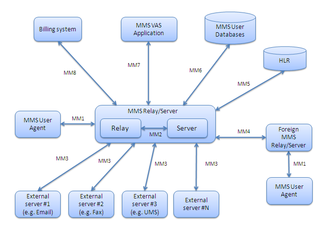- Multimedia Messaging Service
-
For other uses, see MMS (disambiguation).
Multimedia Messaging Service, or MMS, is a standard way to send messages that include multimedia content to and from mobile phones. It extends the core SMS (Short Message Service) capability that allowed exchange of text messages only up to 160 characters in length.
The most popular use is to send photographs from camera-equipped handsets, although it is also popular as a method of delivering news and entertainment content including videos, pictures, text pages and ringtones.
The standard is developed by the Open Mobile Alliance (OMA), although during development it was part of the 3GPP and WAP groups.
Contents
History
Multimedia messaging services were first developed as a captive technology that would enable service providers to "collect a fee every time anyone snaps a photo."[1]
Early MMS deployments were plagued by technical issues and frequent consumer disappointments, such as having sent an MMS message, receiving a confirmation it had been sent, being billed for the MMS message, to find that it had not been delivered to the intended recipient. Pictures would often arrive in the wrong formats, and other media elements might be removed such as a video clip arriving without its sound.
At the MMS World Congress in 2004 in Vienna, all European mobile operator representatives who had launched MMS, admitted their MMS services were not making money for their networks. Also on all networks at the time, the most common uses were various adult oriented services that had been deployed using MMS.
China was one of the early markets to make MMS a major commercial success partly as the penetration rate of personal computers was modest but MMS-capable cameraphones spread rapidly. The chairman and CEO of China Mobile said at the GSM Association Mobile Asia Congress in 2009 that MMS in China is now a mature service on par with SMS text messaging.
Europe's most advanced MMS market has been Norway and in 2008 the Norwegian MMS usage level had passed 84% of all mobile phone subscribers. Norwegian mobile subscribers average one MMS sent per week.
By 2008 worldwide MMS usage level had passed 1.3 billion active users[2] who generated 50 billion MMS messages[3] and produced annual revenues of 26 billion dollars.[4]
Technical description
MMS messages are delivered in a completely different way from SMS. The first step is for the sending device to encode the multimedia content in a fashion similar to sending a MIME e-mail (MIME content formats are defined in the MMS Message Encapsulation specification). The message is then forwarded to the carrier's MMS store and forward server, known as the MMSC. If the receiver is on another carrier, the relay forwards the message to the recipient's carrier using the Internet.[5]
Once the MMSC has received a message, it first determines whether the receiver's handset is "MMS capable", that is it supports the standards for receiving MMS. If so, the content is extracted and sent to a temporary storage server with an HTTP front-end. An SMS "control message" containing the URL of the content is then sent to the recipient's handset to trigger the receiver's WAP browser to open and receive the content from the embedded URL. Several other messages are exchanged to indicate status of the delivery attempt.[6] Before delivering content, some MMSCs also include a conversion service that will attempt to modify the multimedia content into a format suitable for the receiver. This is known as "content adaptation".
If the receiver's handset is not MMS capable, the message is usually delivered to a web based service from where the content can be viewed from a normal internet browser. The URL for the content is usually sent to the receiver's phone in a normal text message. This behaviour is usually known as the "legacy experience" since content can still be received by a phone number, even if the phone itself does not support MMS.
The method for determining whether a handset is MMS capable is not specified by the standards. A database is usually maintained by the operator, and in it each mobile phone number is marked as being associated with a legacy handset or not. It can be a bit hit and miss since customers can change their handset at will and this database is not usually updated dynamically.
E-mail and web-based gateways to the MMS (and SMS) system are common. On the reception side, the content servers can typically receive service requests both from WAP and normal HTTP browsers, so delivery via the web is simple. For sending from external sources to handsets, most carriers allow MIME encoded message to be sent to the receiver's phone number with a special domain. An example of this would be PTN@messaging.carrier.com, where PTN is the public telephone number. Typically the special domain name is carrier specific.
Challenges
There are some interesting challenges with MMS that do not exist with SMS:
- Content adaptation: Multimedia content created by one brand of MMS phone may not be entirely compatible with the capabilities of the recipient's MMS phone. In the MMS architecture, the recipient MMSC is responsible for providing for content adaptation (e.g., image resizing, audio codec transcoding, etc.), if this feature is enabled by the mobile network operator. When content adaptation is supported by a network operator, its MMS subscribers enjoy compatibility with a larger network of MMS users than would otherwise be available.
- Distribution lists: Current MMS specifications do not include distribution lists nor methods by which large numbers of recipients can be conveniently addressed, particularly by content providers, called Value-added service providers (VASPs) in 3GPP. Since most SMSC vendors have adopted FTP as an ad-hoc method by which large distribution lists are transferred to the SMSC prior to being used in a bulk-messaging SMS submission, it is expected that MMSC vendors will also adopt FTP.
- Bulk messaging: The flow of peer-to-peer MMS messaging involves several over-the-air transactions that become inefficient when MMS is used to send messages to large numbers of subscribers, as is typically the case for VASPs. For example, when one MMS message is submitted to a very large number of recipients, it is possible to receive a delivery report and read-reply report for each and every recipient. Future MMS specification work is likely to optimize and reduce the transactional overhead for the bulk-messaging case.
- Handset Configuration: Unlike SMS, MMS requires a number of handset parameters to be set. Poor handset configuration is often blamed as the first point of failure for many users. Service settings are sometimes preconfigured on the handset, but mobile operators are now looking at new device management technologies as a means of delivering the necessary settings for data services (MMS, WAP, etc.) via over-the-air programming (OTA).
- WAP Push: Few mobile network operators offer direct connectivity to their MMSCs for content providers. This has resulted in many content providers using WAP push as the only method available to deliver 'rich content' to mobile handsets. WAP push enables 'rich content' to be delivered to a handset by specifying the URL (via binary SMS) of a pre-compiled MMS, hosted on a content provider's web server. A consequence is that the receiver who pays WAP per kb or minute (as opposed to a flat monthly fee) pays for receiving the MMS, as opposed to only paying for sending one, and also paying a different rate.
Although the standard does not specify a maximum size for a message, 300 kB is the current recommended size used by networks due to some limitations on the WAP gateway side.[citation needed]
Interfaces
Main article: MMS Architecture- MM1: the 3GPP interface between MMS User Agent and MMS Center
- MM2: the 3GPP interface between MMS Relay and MMS Server
- MM3: the 3GPP interface between MMS Center and external servers
- MM4: the 3GPP interface between MMS Centers
- MM5: the 3GPP interface between MMS Center and HLR
- MM6: the 3GPP interface between MMS Center and user databases
- MM7: the 3GPP interface between MMS VAS applications and MMS Center
- MM8: the 3GPP interface between MMS Center and the billing systems
- MM9: the 3GPP interface between MMS Center and an online charging system
- MM10: the 3GPP interface between MMS Center and a message service control function
- MM11: the 3GPP interface between MMS Center and an external transcoder
See also
- Enhanced Messaging Service (EMS)
- Mobile marketing
- Short code
- Synchronized Multimedia Integration Language
References
- ^ Parks, Bob (October 2000). "Wired Magazine, The Big Picture - Philippe Kahn". http://www.wired.com/wired/archive/8.10/kahn.html. Retrieved 2006-04-20.
- ^ Ahonen, Tomi T. Tomi Ahonen Almanac 2009.
- ^ ABI Research 2008
- ^ "Mobile Messaging Futures 2009-2013: Analysis and Growth Forecasts for Mobile Messaging Markets Worldwide: 3rd Edition". Portio Research. 2009. p. 2. http://www.portioresearch.com/MMF09-13_brochure.pdf. Retrieved June 24, 2010. Brochure. Full report page.
- ^ "Overview of MMS", mbuni
- ^ "Sending MMS Notifications and Content", now.sms
External links
- "Multimedia Messaging Service 1.3". Open Mobile Alliance. http://www.openmobilealliance.org/Technical/release_program/mms_v1_3.aspx. Retrieved 14 Jan. 2009.
- "Consumer Best Practices Guide for Cross-Carrier Mobile Content Programs (United States)". Mobile Marketing Association. http://www.mmaglobal.com/bestpractices.pdf. Retrieved 14 Jan. 2009.
- Eicher, Richard (13 Jan. 2009). "Advances in MMS offer interactive tools to mobile marketers". Mobile Marketer. http://www.mobilemarketer.com/cms/opinion/columns/2440.html. Retrieved 14 Jan. 2009.
- Morrison, Diane See (17 Sept. 2008). "BMW MMS Campaign Gets 30 Percent Conversion Rate". mocoNews.net. http://www.moconews.net/entry/419-bmw-mms-campaign-gets-30-percent-conversion-rate/. Retrieved 14 Jan. 2009.
- "A Guide to Multimedia Messaging". Mediaburst. http://www.mediaburst.co.uk/blog/multimedia-messaging-mms-guide/. Retrieved 03 Sep. 2009.
- "A MMSC Lab Server to run tests". SSA Securenet Sistemas Avanzados. http://www.azcalabs.com/. Retrieved 28 Jan. 2010.
Mobile phones General Applications Application development · Application distribution · Banking · Blogging · Commerce · Content · Gambling · Gaming · Health · Instant messaging · Learning · Local search · Location tracking · Marketing · MMS · Music · News · Payment · Publishing · Push e-mail · SMS · Telephony · Text messaging · Ticketing · Web · Cloud computingCulture Devices Environmental health Law Networking Channel capacity · Frequencies · Network operators · Signal · SIM · Standards comparison · VoIP · WAP · XHTML-MP
Generations: 0G · 1G · 2G · 3G · 4G · 5GStandards Draft standards Categories:- 3rd Generation Partnership Project standards
- Mobile telecommunication services
- Mobile telecommunications standards
- Open Mobile Alliance standards
Wikimedia Foundation. 2010.



